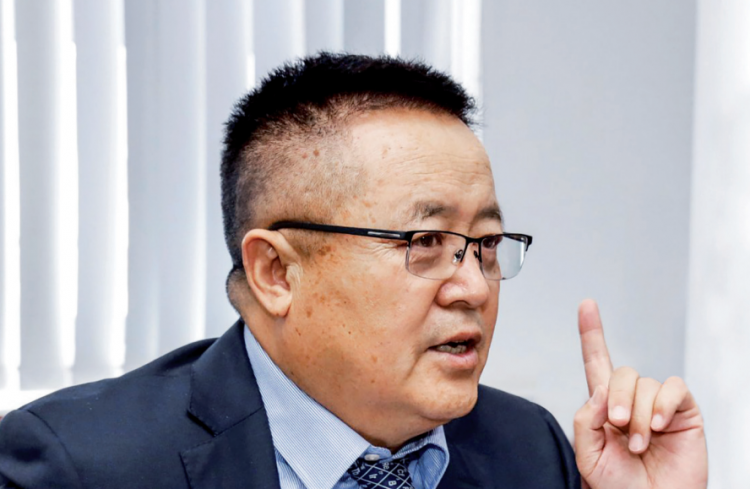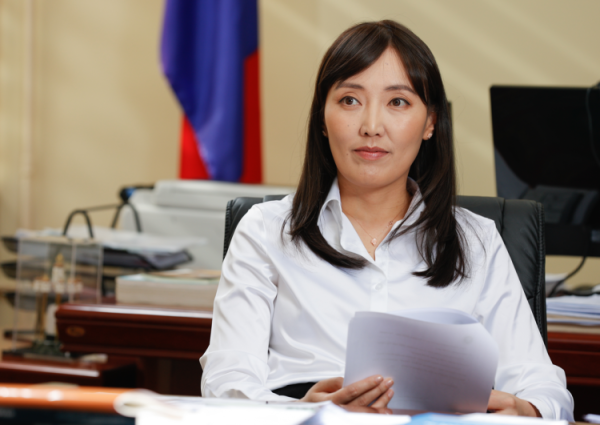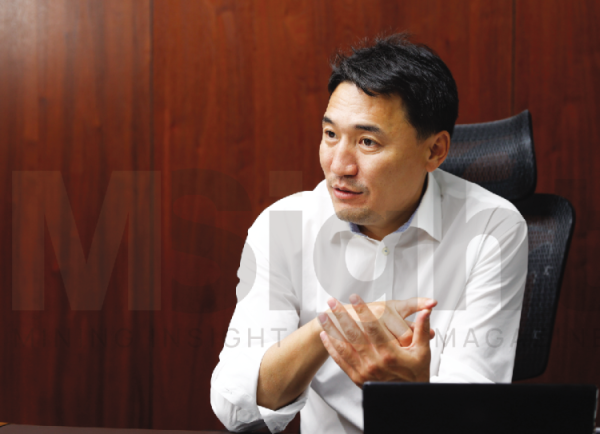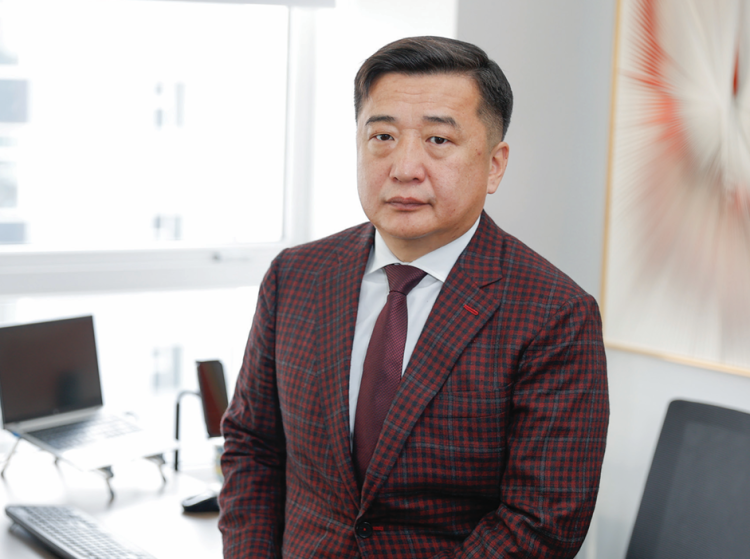 Dalanguerban.A, Executive Director and CEO of “SouthGobi Resources” spoke with Bayartogtokh. B of Mining Insight.
Dalanguerban.A, Executive Director and CEO of “SouthGobi Resources” spoke with Bayartogtokh. B of Mining Insight.How much coal did your company mine last year and how much did it export? Will production and export plans increase this year compared to last year?
Our company exported 3.7 million tonnes of coal in 2019. The overall volume shrank to 2.72 million tonnes in 2020 due to COVID. Last year, it was about 1.1 million tonnes. Export volume has been declining over the years in line with China’s border restrictions to prevent the Covid-19 outbreak. The border was closed in October 2021 and opened only in May of this year. In these three months, our company has produced over 200,000 tonnes of coal. The sharp slip in exports is a big problem for us. The Shiveekhuren border checkpoint was the best route for us in 2019, delivering over 12 million tonnes of coal. It has been widely discussed that the capacity can be doubled to 25 million tonnes. Both coal reserves and mining capacity are there to export 25 million tonnes. But the bottleneck at the border downsizes this potential. Companies cannot act alone.
What steps do you think are necessary to increase exports?
Due to the pandemic, coal is sent by container to avoid human contact. The daily number of coal trucks passing the border fell to 210, which is nowhere near the average of previous years. The biggest problem is the situation at the border. Without improving border management and border entry methods, the export volume cannot increase and difficulties will persist even if the COVID-19 restrictions ease completely. The Ministry of Mining and Heavy Industry is well aware of the situation. The ministry is also committed to improving exports. The Mongolian government is holding official meetings and talks with its southern neighbor, but the above issue has not been resolved so far. If the two countries can reach common ground on border and customs issues, and increase the number of border crossing gates, growth potential is already there. This is one of the two biggest problems that companies cannot solve alone. As for the second issue, according to the Miner al Law, royalties must be paid for mineral resources. Companies have never shied away from paying. The main problem is the reference price. We export thermal coal. The price is around CNY 200 per tonne. However, the reference price is based on the price in China’s domestic area. Of course, the Chinese market price is high. We are supposed to pay 5 percent tax under the current royalty, but considering the benchmark price, we are paying 10-20 percent tax. Mongolian Coal Association has appealed to the Government, the Ministry of Finance, and the Administrative Court on this issue, but it has not been resolved.
The government approved a new classification of coal this month. Will it help with the issues around reference prices and royalties?
We’re not seeing any positive changes so far. In fact, before reforming the Law on Minerals, taxes were deducted the same whether you earn USD 1,000 or 5. However, the standard price changed this principle. Sometimes, when coal prices are low, the company makes no profit after paying taxes. The taxes should be deducted from sales revenue or contract price. I think that would be more realistic.
You’ve produced over 200,000 tonnes of coal so far this year. How do you intend to work in the future?
We have four months until the end of the year. Because our monthly export is falling short of 200,000 tonnes, we will be exporting 1 million tonnes at most this year. That would be our lowest annual volume. The export duration was short with heavy disruption to transportation. There is another issue with border crossing. The Chinese side issues permission that we call white paper. This isn’t renewed. The Mongolian side issues permission C. We observe several human interventions, such as hindering drivers to allow entry in return for a favor. I think the regulation should be market-based rather than requiring such permits. Truck drivers either don’t have coal to transport or don’t have permits. We are facing an issue where no permitted vehicles are available for mines to transport their coal. This is the same for both sides of the border. If we increase the number of gateways and transport according to market principles, exports will increase dramatically. The current capacity of 12 million tonnes can easily be increased to 20 million.
Is there any stockpile at your mine?
Yes, there is. We call it a reserve. It exceeded 900,000 tonnes in May and now we have over 600,000 tonnes available for sale. The quality of stockpiles wears out the longer it is exposed to sun and wind. Not to mention wind erosion, drying, and loss of durability. The new labor law was enforced recently.
Did it have any impact on your normal operations?
It is causing a lot of problems. The law, which came to force in January, stipulates that mine workers will work 14 days in a long shift. Personally speaking, it is not easy to stay at home after working for 14 days and doing nothing for 14 days. On the other hand, wages are calculated by working hours. Because of this, the workers’ salary was cut by 30-40 percent.
Is this the right decision for the person you are working with? How can you feed your family with a 30 percent lower salary?
The solution is to find a second job. People indeed say mining jobs are hard. However, most of the mining work is done by machinery and not hard labor. Therefore, it is challenging to consider this a thoughtful and scientific decision. 100 people work at our company in a 21-day shift. But to have a 14-day shift, we had to hire an additional 30-40 people. Of course, the cost of the company is increasing because of the additional salaries and transportation costs. Labor law is meant to protect the workers’ rights. However, by strictly legislating the shift at 14 days, both the salaries of the employees and the company’s operations have been disrupted.
What changes have been made in the salary system because of this?
In terms of corporate management, I pay attention to two things. First, the interests of the company’s shareholders, and increasing the profit as much as possible. Secondly, the rights of workers. This includes health and salary among many other things. Our company surveyed in June. I met with employees on 14 day-shift and decided to raise their salaries by about 30 percent due to the new labor law. This is the company’s decision based on the current situation. Mine workers are happy. Those who had previously quit are now willing to return. As far as I know, our company is the only one that has taken such measures.
How will your company support and get involved in the border control reform?
Companies operating in the area, such as MAK and Usukh Zoos are jointly building a container terminal. On top of that, the sides established a joint company of sorts to fund these activities depending on their share of its ownership. It started last fall, but it’s still not finished yet.
There is a delay in the process. The initiative is right but difficult to implement. AGV is much better than the ART we are currently working on. Smart transportation is widely used by large Chinese companies at seaports. This was rejected and a different technology was selected. Lights were installed along the road for trucks to stay on the path. But AGV is a smart technology, so there was no need for such a thing. It navigates itself using 5G. However, the current solution is very limited and cannot increase volume. Many Chinese companies are expressing interest to buy coal. But the bottleneck at the border crossing is disrupting the supply side. China is having a serious shortage of thermal coal for over a year. Mongolia is currently exporting coal and other mining products only to the Chinese market. Due to the relations between the countries, there are various problems and opportunities. For example, the deterioration of relations between China and Australia has created great opportunities for Mongolian coal. I hope Mongolia will make good use of it this time. Firstly, the price is very high. Buyers are ordering mass delivery. The source of energy will shift significantly in the next 40-50 years, shying away from coal. Energy will be produced from other new sources. That is why I want to use this period to its full potential. As far as I know, this is an opportunity that did not appear in years. Almost 10 years ago, when I was not working in the coal industry, there was a meeting between two coal companies in China. At that time, I heard of Mongolia’s coal sector. At that time, I was in the field of non-ferrous metals, copper, and zinc. When some people said China has set a fixed price by force, I thought it was true. Mongolia’s coal quality is good, but transportation costs are high. The fact that Mongolian coal is not affordable is affecting transportation. That was an issue 10 years ago, and it still is. The high cost of transportation is because it is transported by trucks and travels a long distance on dirt roads. There were also issues such as the fact that trucks would break down easily when driving on a dirt road, and that they would use a lot of diesel fuel. I estimated at that time, Mongolian coal will have to travel 300-400 km to cross the border. 2000 km is always expensive to transport by vehicle. On the other hand, higher quality washed coal is transported by sea from Australia. Almost 100,000 tonnes will be supplied in one go. The cost per unit is very low. Once it arrives at the port, it is much closer to power plants, the final consumers. Mongolian coal is used to compete with Australian coal in the Chinese market. The demand for Mongolian coal is only in the southeast region of China. In such a situation, it is a misconception that China is suppressing prices. Because Mongolia exports raw coal. I thought we should look more into the competition with Australian-washed coal. However, a decade has passed and we’re still in the same situation. It cannot be denied that the economic impact of the pandemic was huge. If we want to develop Mongolia’s economy and produce more coal, we must reduce transportation costs. The government and people understand this now. It’s a little late now, but it’s enough to get the gist of the situation. Therefore, our five companies decided to build a terminal together. We need to make use of the current heightened demand for Mongolian coal in the Chinese market. I understood that the government was speaking through diplomatic lines. The government is sticking to the mining policy of extraction and processing to sales. I have been working in the Mongolian mining industry for about 30 years. From my experience, we better take action based on facts and research. In the 1980s, when China was carrying out economic reforms and expanding its relations with other countries, it sold mining raw materials such as coal, copper concentrate, and zinc. Now, the country can’t even cover its domestic consumption. First, the company started selling processed concentrates, and then, melting them. Now, China no longer exports commodities, not even sand. Mongolia has also been saying that it will produce final products for many years. This is the correct way forward. Indonesia produces a lot of copper concentrate. It is said that a metallurgical plant must be built to sell its products. Otherwise, there is a 20-30 percent tax. Therefore, companies are forced to build metallurgical plants. Therefore, I think that the government needs to regulate Mongolia’s natural resources not only by extracting them from raw materials but also by adding value. The best way is to tax. If you pay a 20% tax on raw coal, the company will automatically set up a factory to retain its profit. Therefore, it is necessary to study when exporting. This can only be possible with policy support. They are talking about supporting the final product in Mongolia. The main thing is that support should be regulated through taxes. Pay more tax if you want to export it raw, and grant tax incentives to washed coals so that companies consider washing it as much as possible. It is beneficial for Mongolia.
What are your plans for washing, enrichment, and adding value?
I have been with this company for two years. We had an old washing plant. We’re renovating the plant and installing flotation equipment. Some fine particles of coal are discarded along with the mud. Almost 10 percent is discarded this way. By flotation, we can in crease volume by about 10 percent. On the other hand, the Chinese market does not have very high requirements for the calorific quality of thermal coal. It is about 4800 kcal. Our washed coal reaches 6000 kcal.
In addition, our coal has 15 percent rock content. The cost of transporting 1 million tonnes of coal equals the value of 150,000 tonnes. On top of the transportation cost, we pay a royalty for that rocks. In other words, we are selling low-quality coal at a cheap price.
Our total output is 3 million tonnes. If you wash it, the size will be the same, but the price will be different. We need profit, so we wash and enrich the coal. A very small part of our coal is coking coal. We are selling our coal because we cannot differentiate them apart. We’ll be able to export coking coal by washing and cleaning thermal coal. Regular coal is valued at CNY 200 per tonne. If it is converted into coke, the price will be much higher at around CNY 700-800 per tonne. In addition to adding value, the policy is to get the real value of coal. The activities started this year will be finished next year.
How is your company supporting the “One Billion Trees” national initiative?
I am Mongolian too. I want to preserve nature. Our company strongly supports the “One Billion Trees” initiative. When the president signed a memorandum of understanding with over 20 companies to plant trees, our company committed to planting 15 million trees. We will commit to our promise. Our mine is located 15 km from the border in Gurvantes soum of Umnugovi province. Across the border, China has implemented a major green policy since the early 1980s to combat sandstorms. So they have a lot of experience in this area. Therefore, I talked to many Chinese arboriculture centers about how to grow trees in the Gobi region. From here, we chose 6-7 types of trees suitable for the Gobi region of Mongolia and planned to start planting them in September. In addition to Umnugovi, we also applied for land for tree propagation in other provinces. There is also a plan to plant trees along the coal transportation route.
How would you assess Mongolia’s investment environment?
We have been talking about Mongolia’s investment environment for many years. Last spring, during a meeting on the investment environment, I represented my Chinese companies and gave my opinion. When talking about the need for investment, we leave out one factor. It is a question of how to protect incoming investments. Mongolia claims that it is open and supports investment, but it does little to protect that investment and investor. So it ends up being empty talks. Investment attracts investment. If the investment environment is good, investors will come. The story of how people suffered losses investing in Mongolia will disdain the country’s reputation. In general, Mongolian society does not care about incoming investments. The legal framework is not bad, but implementation is problematic. Too much power has been given to local governments. One example is licensing. The local government disregards licenses issued by the Mineral Resources and Petroleum Authority of Mongolia and demands signatures from some government officials. Sometimes those officials go absent. This problematic bureaucracy annoys investors.



























